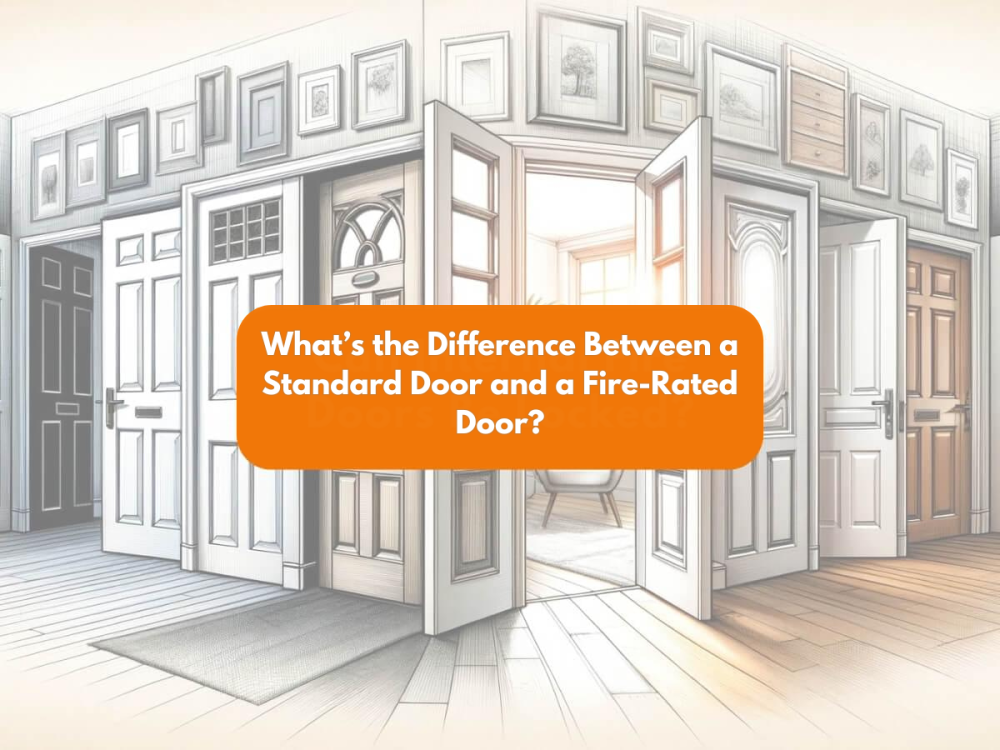How have cottage door designs evolved over the decades?
Key Takeaways:
| Key Takeaways | Description |
|---|---|
| Introduction to Cottage Doors | Cottage doors are more than just an entrance—they're a statement of cottage architecture. |
| History of Cottage Architecture | Cottage architecture originated in mediaeval Europe, when 'cottage' meant a rural folk's simple home. |
| The Rise of Decorative Cottage Doors | As the Industrial Revolution began, the Victorian and Arts and Crafts periods brought more decorative aspects to cottage doors. |
| The Future of Cottage Door Designs | The future of cottage door designs seems to be one of convergence between tradition and innovation. |
| FAQs & Common Concerns | Despite their traditional appearance, modern cottage doors can be equipped with advanced locking mechanisms |
Introduction to Cottage Doors
Cottage doors are much more than a mere entrance to a home; they're a statement piece that encapsulates the essence of cottage architecture. Their rustic charm and robust design reflect an era when doors were not just functional but also a key aesthetic element of a home.
Cottage doors serve a dual purpose: they protect and personalise. They add character to the cottage's façade and create an inviting threshold that bridges the gap between the natural world outside and the cosy haven within. Nowadays, cottage doors are also utilised inside homes and not merely displayed externally. You can have a White Primed Internal Door, adding elegance to your home.
A Brief History of Cottage Architecture
The roots of cottage architecture dig deep into the soils of mediaeval Europe, where the term 'cottage' originally described the humble dwelling of rural folk. Over time, this architectural style has blossomed across various regions, with each era leaving its unique mark on the designs
| Period | Region | Characteristics |
|---|---|---|
| Medieval | Europe | Basic structures made with local materials, thatched roofs, small windows. |
| Tudor | England | Half-timbered exteriors, large chimneys, diamond-paned windows. |
| Victorian | Europe & America | Ornate decorations, gable roofs, asymmetry. |
These styles reflect local materials, climatic considerations, and cultural influences, showcasing the evolution of cottage architecture through the lens of time and place.
The Significance of Cottage Doors in Architectural History
Cottage doors are historical storytellers; they reflect the socioeconomic changes and cultural evolution through their design and material usage.
Over time, door designs have evolved, reflecting shifts in society, economics, and culture. From simple wooden doors in peasant homes to ornate Victorian entries, these changes signify societal hierarchy and norms. Economic factors, such as material availability and technological advancements, have transformed doors into decorative symbols of affluence or utilitarian elements during economic downturns. Additionally, local traditions and craftsmanship have left their mark on door styles, adding cultural diversity and heritage to the evolving designs. In essence, door designs encapsulate the dynamic interplay of social, economic, and cultural influences throughout history.
These doors stand as thresholds between private and public realms, often reflecting the homeowner's status and taste. They're not just passageways but pivotal elements that define the character of a cottage, embodying its history and the stories within.
The Evolution of Cottage Door Designs
Early Cottage Doors: Simplicity and Functionality
Cottage doors, from their inception, have been the epitome of simplicity and functionality. The early designs featured robust solid timber construction, often utilising local woods which added to the door's character and durability. Simplicity was paramount, with straightforward panel designs and sturdy iron hinges being the norm. This no-frills approach was born out of necessity; resources were scarce, and construction techniques were basic. Yet, these doors served their purpose well, protecting the inhabitants from the elements and securing the home.
The charm of early cottage doors also lay in their regional variations. These differences were not just aesthetic but spoke volumes about the locality's available resources and the prevailing craftsmanship traditions. For instance, in areas abundant with oak, the doors would typically be made from this hardy wood, known for its strength and longevity. In coastal regions, the designs might have incorporated elements resistant to the corrosive sea air.
| Region | Material Used | Design Characteristics | Notable Features |
|---|---|---|---|
| Inland Areas | Oak | Thick panels, heavy-duty ironwork | Durability, resistance to warping |
| Coastal Areas | Local Hardwood | Simpler forms, salt-resistant finish | Adaptability to harsh weather conditions |
| Mountainous Regions | Pine | Lighter construction, rustic appearance | Integration with natural surroundings |
These doors were not just barriers but a testament to the ingenuity and adaptability of our ancestors, who crafted enduring entryways with the limited means at their disposal.
The Rise of Decorative Cottage Doors
As the Industrial Revolution took hold, the Victorian and Arts and Crafts movements ushered in a new era for cottage doors, marked by an increase in decorative elements. The once simple doors began to boast intricate carvings, elegant mouldings, and the use of stained glass panels, reflecting the homeowners' status and the period's artistic inclinations.
This era's hallmark was the fusion of form and function, with Gothic Revival and Tudor Revival styles influencing the cottage door designs. The Arts and Crafts movement, in particular, emphasised craftsmanship and natural materials, leading to bespoke doors that were as much works of art as they were functional components of the home.
The Victorian period revelled in ornate designs, with doors featuring elaborate patterns and sometimes even symbolic motifs. Meanwhile, the Arts and Crafts doors leaned towards a celebration of the material and handiwork, often showcasing the wood's natural grain with simpler, yet thoughtfully designed panels and glasswork.
The Influence of Modern and Contemporary Designs
In the modern era, cottage door designs have been transformed by contemporary architectural styles. The focus shifted towards clean lines, minimalist forms, and often geometric patterns. This table showcases the stark contrast in design philosophy between traditional and modern cottage doors:
Modern materials like aluminium, glass, and composites have become prevalent, offering new possibilities in terms of durability, maintenance, and aesthetic flexibility. These materials also lend themselves to more innovative designs, accommodating the changing tastes and requirements of contemporary homeowners.
The Adaptation of Cottage Door Designs to Regional Styles
Cottage door designs have always been a reflection of the region they originate from, incorporating local architectural styles, materials, and cultural traditions. Today, this regional diversity is celebrated more than ever, with designs that pay homage to local vernacular while embracing modern influences.
The English cottage door, for instance, often features a sturdy oak construction with a warm, welcoming design. In contrast, the French farmhouse door may exhibit a more elegant, rustic charm with the use of painted timber and wrought iron hardware. American Craftsman doors borrow from the Arts and Crafts movement, prioritising handcrafted quality and natural materials.
| Region | Design Influences | Materials and Characteristics |
|---|---|---|
| England | Traditional, warm, solid construction | Oak, stained glass |
| France | Rustic elegance, painted finishes | Timber, wrought iron |
| America | Arts and Crafts, handcrafted quality | Natural wood, glass panels |
These regional interpretations of the cottage door not only enrich the architectural tapestry of their respective locales but also contribute to a global appreciation for the diversity and adaptability of cottage door designs.
The Personalisation of Cottage Doors in Modern Homes
Customisation: A Key Trend in Door Design
In the realm of modern internal cottage doors, personalisation stands as a prominent trend. Today's homeowners yearn for uniqueness, leading to a surge in demand for bespoke doors. These custom-made doors cater to specific aesthetic preferences and practical requirements, reflecting individual personalities and stories.
Bespoke doors are not mere entryways but personal statements. They come in a myriad of styles, from the minimalist and sleek to the ornate and traditional. The choice of materials has expanded too, with sustainable options like bamboo and reclaimed wood becoming increasingly popular.
Here are some of the ways in which modern cottage doors can be personalised:
- Colour Choices: Bold or pastel, the colour of a door can set the tone for the home's overall aesthetic.
- Glasswork: Custom stained or etched glass can add a touch of elegance and privacy.
- Hardware: From vintage brass to contemporary chrome, door hardware is a detail that can significantly influence the door's style.
- Sizing: Custom sizes ensure that the door fits perfectly, essential for older cottages with non-standard door frames.
Technology Integration in Cottage Doors
Advancements in technology have not bypassed the humble cottage door. Smart locks, video doorbells, and advanced insulation materials are being integrated into door designs to enhance security and energy efficiency.
Smart locks dispense with the need for traditional keys, offering access via smartphones, keypads, or biometrics. Video doorbells add a layer of security, allowing homeowners to see and communicate with visitors remotely.
Energy efficiency is also a critical consideration, with modern doors featuring advanced weather stripping, double or triple glazing, and high-performance cores to reduce heat loss.
The Sustainability Movement in Door Manufacturing
Sustainability is a driving force in contemporary door manufacturing. As environmental awareness grows, so does the demand for doors made from responsibly sourced materials and eco-friendly processes.
Many modern manufacturers now offer doors made from Forest Stewardship Council (FSC) certified wood, ensuring that the timber is harvested in a way that preserves forests. Recycled materials are also coming to the forefront, with doors being made from repurposed woods and metals, which not only reduces waste but also provides a unique aesthetic appeal.
Here is a breakdown of sustainable door materials:
- FSC Certified Timber: Ensures responsible forest management.
- Recycled Materials: Promotes circular economy and adds uniqueness.
- Low VOC Finishes: Reduces harmful emissions, ensuring better indoor air quality.
The Future of Cottage Door Designs
Looking ahead, the future of internal cottage door designs seems to be one of convergence between tradition and innovation. While the nostalgic allure of classic designs persists, new technologies and sustainable practices are shaping the doors of tomorrow.
The trend towards personalisation is likely to continue, with even more options for customisation becoming available. The integration of smart home technology is expected to become standard, and sustainability will drive innovation in materials and manufacturing processes.
In summary, the cottage door, while rooted in tradition, is evolving to meet the modern homeowner's needs for personalisation, security, energy efficiency, and sustainability. The doors that have protected and adorned homes for centuries are set to become smarter, greener, and more reflective of the individuality of those who dwell behind them.
FAQs
Q: What defines a cottage-style door?
Cottage-style doors typically feature a rustic design, often with natural wood finishes, vertical planking, and sometimes with small windows or ledges. They aim to create a cozy, charming appearance that complements cottage architecture.
Q: Can cottage doors be customised?
Yes, cottage doors can be tailored to individual preferences, including size, colour, finish, and the inclusion of glass panes or ironwork, ensuring they fit the specific style and dimensions of a home.
Q: Are cottage doors secure?
Despite their traditional appearance, modern cottage doors can be equipped with advanced locking mechanisms and robust materials, offering a level of security that meets contemporary standards.
Q: How do I maintain a wooden cottage door?
Regular maintenance includes checking for weather damage, applying protective treatments like oils or varnishes, and ensuring that moving parts such as hinges are well-lubricated.
Q: Are cottage doors energy efficient?
The energy efficiency of a cottage door depends on its material and construction. Solid wood doors with proper sealing are generally good insulators. Some modern cottage doors also come with energy-efficient features such as thermal cores or double-glazed windows.











